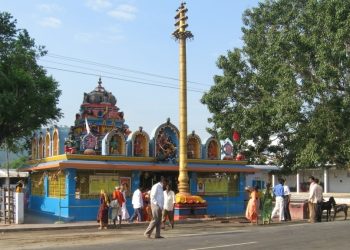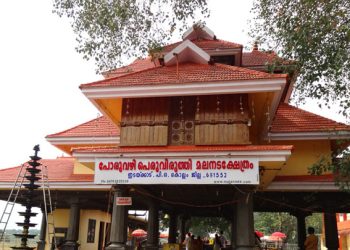Talakad is a town on the left bank of the Kaveri river at a spot where the river makes a sharp bend. It is 45 km from Mysore and 140 km from Bangalore in Karnataka, India. A historic site, Talakad once had over 30 temples that today are buried in the sand. Now it is a scenic and spiritual pilgrimage center. Here the eastward flowing Kaveri river changes course and seems magnificently vast as here the sand on its banks spreads over a wide area.
Shrine’s History
Tala and Kada, the two hunters, after whom my guide says, this town in named. One more story, this time, it fuses a bit of religion as well. A sage, Somadatta and his disciples were killed by wild elephants when they were doing their penance. They were said to be reborn as elephants in the same forest. Two hunters, Tala and Kada watched the ritual of the elephants offering prayers to a silk cotton tree. And out of curiosity, axed the tree down, only to find it bleeding. A voice then instructed them to heal the wound with the leaves and the blood miraculously turned milk which immortalised the hunters and the elephants as well. A temple later was built here around the tree, and the place became known as Talakadu. In 1634 it was conquered by the Mysore Rāja under the following circumstances. Tirumala-Raja, sometimes called Srī Ranga Raya, the representative of the Vijayanagar family at Srirangapatna, being afflicted with an incurable disease, came to Talkad for the purpose of offering sacrifices in the temple of Vedesvara. His wife Rangamma was left in charge of the Government of Srirangapatna ; but she, hearing that her husband was on the point of death, soon after left for Talkad with the object of seeing him before he died, handing over Srirangapatna and its dependencies to Rāja Wodeyar of Mysore, whose dynasty ever afterwards retained them. It appears that Rāja Wodeyar had been desirous of possessing a costly nose-jewel which was the property of the Rāni, and being unable to obtain possession of it by stratagem, and eager to seize any pretext for acquiring fresh territory, he levied an army and proceeded against Talkad, which he took by escalade ; the Raja of latter place falling in the action.
The Rani Rangamma thereupon went to the banks of the Cauvery, and throwing in the jewel, drowned herself opposite Mālingi, at the same time uttering a three-fold curse,-“Let Talakad become sand; let Malinga become a whirlpool; let the Mysore Rajas fail to beget heirs.” The latter part is now happily of no effect. The following is what is known as the curse of Talakad, in the original – Talakadu Marulagi. Malingi maduvagi Mysore maharajarige makkalagade hogali.
Architectural Relevance of This Shrine
The Vaidyanatha temple was constructed by the Chola kings who ruled this part of Karnataka in the 14th century. This temple was built in the Dravidian style and has two huge Dwarapalakas standing at the entrance to the main shrine. The doorways are intricately carved and the outer walls to are covered in sculptures. There is a beautiful figure of Ganesha riding on his vehicle, the mouse. There is also a statue of Nandi installed at the entrance. The walls are covered by depictions of various forms of Shiva and Vishnu. A beautiful chain of granite rings is sculpted at one end of the outer roof. These rings hang down from the roof, with no joints. It is a magnificent piece of workmanship when the artisans had nothing but a chisel and hammer to work with.
By Road
Talakad has located at a distance of 185 km from Bangalore and 45 km from Mysore. Frequent bus services will be available from these places.
By Rail
There is no direct train to Talakad. One needs to come via train till Mysore and then further plan the journey. Bus transportation is available to take you to the temple.
By Air
There is no domestic airport in here. The nearest airport is in Mysore. One can easily fly to Mysore as it is connected to major cities in India. The place is around 60 km away from Mysore. There are public and private buses available from here to Talakad. The journey is painless and comfortable.
Shrine Timings
Temple opening and closing time
Morning 8:30 to 1:30
Evening 4:30 to 8:30
Dhanurmasa Morning 3:30 to 7:30
Morning 8:30 to 1:30
Evening 4:30 to 8:30
Saturday & Sunday – Holidays
Morning 8:30 to 2:30
Evening 3:30 to 8:30
Mudukuthore Morning 7:30 to Evening 7:30 without break
Events Celebrated at This Shrine
Festivals Utsava in Temple
Bandarasamma festival
Jathra Mahothsava at Mudukuthore cattle festival ( Ankuraarpana, Dwajaroohana,
Devataa Aahvana,
Chandramandala Aaroohana,
Sheshavaahanosthava (Anantha Pitaaroohana),
Pushpa Mantapoosthava (Hovin chappara),
Vrushaabaaroohana (Basava Vahanooshava),
Girija Kalyana / Gjaroohana , Bramma Rathooshava,
Shayanoosthava,
Avabrutha Teertha Sthana,
Panchoopachara, Nandhi vaahanoosthava,
Thepoosthava,
Marithepoosthava,
Kailasa Vahanosthava,
Mantaposthava,
Giri pradakshine,
Basava Maale, Shettara seve.
Vaidyanatheshwara Prathyakshosthava Maarkandeyosthava Uyaloosthava / Shiva Sayanosthava Aadi Sukravara pooja Aashada Sukravara Karthika Masa pooja Kruthikoosthava Chikka Jathre (Parvatha Parishe at Mudukuthore) Aridroosthava Manonmani Ammanavara Vardhandi Sankrathi festival Navarathri
Extra Information About this Shrine
Temples
At Talakad sand covers the temples. Stone pillars, square at the base and made to fit into a wheel below the abacus, lie scattered about. Among the temples of Talakad, the Pathaleshwara, Maruleshwara, Arkeshwara, Vaidyanatheshwara and Mallikarjuna temples, the five Lingams believed to represent the five faces of Shiva, form the Pancha pathi and have become famous. In honour of these five Shiva temples, a fair is held once every 3 to 12 years called Panchalinga Darshana, last held in 2009. The Panchalinga Darshana is held on a new moon day in the month of Karthika when two stars conjoin, the stars of Khuha Yoga and Vishaka.On this day, tradition has it that pilgrims should first bathe in the Gokarna theertham, worship Gokarneswara and Chowdeswari, and then worship Vaidyeshwara, and then bathe in the northern eastern southern and western stretches of the Kaveri and then worship Arkeshwara, Pataleshwara, Maraleshwara and Mallikarjuna, returning to Vaidyeshwara after each worship, finally worship Keerthinarayana and conclude the pilgrimage in one day. According to local legend, Ramanujacharya during his sojourn in Karnataka (also called Melnadu), established five Vishnu temples of LordNarayana known as Pancha Narayana Kshetrams. Talakad is one of the Pancha Narayana Kshetrams where the Keerthi Narayana temple was established and the presiding Deity in this temple is Keerthi Narayana
Talakadu – Buried under the sands It is the classical Indian story. A tale told by gods and demons, filled with kings and queens, replete with curses and boons. There is a little bit of history here, blended with some geology and topped with legends and myths. Set on the banks of the River Cauvery in Karnataka, this saga dates to the fourth century and has certain intriguing elements, defying the very laws of nature.
Mudukuthore is a pilgrim centre situated on the banks of the river Kaveri. Mudukuthore is a quiet village with a backdrop of a hillock called Somagiri. Mudukuthore is located at 48 km from Mysore, 25 km from Somnathapur, 18 km from T.Narsipur and is close to Talakad. The place is known for the temple of Lord Mallikarjuna. During January-February, every year, a big festival fair is organized for a two week where cattle are traded. This is one of the famous fair which crowds thousands of visitors.
Lord Mallikarjuna temple the place gets its name Mudukuthore from the river cauvery as it gets a turn and flows forward. Muduku means ‘Diversion’ and Thore means ‘flow forward’. During Mahabharatha period, Arjuna, One of the Pandavas stayed here on the hill. He carved the idol of Lord shiva and did pooja with “Mallika pushpa” (a kind of flower). That’s the reason the Lord shiva is called as Mallikarjuna. It is one of the five temples that are part of the Panchalingadarshana held at Talakd once every 3 to 12 years. The five temples viz., Sri Kshethra Vaideshwara, Sri Pathaleshwara, Sri Maruleshwara, Sri Arakeshwara and Sri Mudukuthore Mallikarjuneshwara are believed to be Panchalingas and thus have become famous. The festival takes place simultaneously at the above five temples of Shiva. The temples are decorated with plantain stalks and flowers and the pilgrims undertaking Panchalinga Darshana offer their Pooja to the God. The uniqueness of this festival is that the poojas at the five temples begin at the same time following the ancient tradition for obtaining blessings for devotees and rulers of the country.
The Panchalinga Darshana is held at Talakad in Karnataka and involves the darshan of five Shivling during an auspicious period as per Hindu Panchang. The Panchalinga Darshana constitutes of darshan of Shivling at Vaidyeshwara, Pataleshwara, Maruleshwara, Mallikarjuneshwara and Arakeshwara temples. It is believed that a darshan of the five Shivlings during the special occasion helps in attaining peace and prosperity. People also undertake the darshan to fulfill their desires. Panchalinga Darshana is usually held once in 12, 7, 5 or 3 years at Talakad and depends on specific astrological calculation. But the 12-year cycle is broken depending on astrological calculation. This is Panchalinga darsana lakhs of people throng at this place to have the darsana of five lingas on a day on which strange astronomical combination takes place. This combination is as follows: It should be a new moonday of the month of Kartika and a Monday and the Sun should be in scorpio. This combination occurs at various intervals ranging from four to fourteen years. The last Panchalinga darjana took place on 16-11-2009.
Panchalinga Temples:
VaidyeshwaraTemple
Vasukishwara or Pataleshwara Temple
Saikateshwara or Maraleshwara Temple
Arkeshwara Temple and
Mallikarjuna Temple
Vaidyanatheshwara, Pataleshwara or Vasukishwara, Maruleshwara or Saikateshwara, Arkeshwara and Mallikarjuna temples, the five Lingams believed to represent the five faces of Shiva.
Arkeshwara Temple
This temple is slightly isolated. Near the Arkeshwara temple is the Kottai Vinayagar temple. There are idols for Bhairavar, Durgai and abhayangara lingam in this temple. There is a rock at the entrance with a Vaastu yantram. It is believed that tying deceased cows to this rock will cure them.
Maruleshwara temple
Half a mile to the North of the Keerthi Narayanar temple is the Maruleshwara temple. The huge Siva lingam here is considered to have been installed and worshipped by Lord Brahma. In the front mandapam there are idols of Maheswara, Thirumal, Ambigai, Surya, Ganapathi, Shanmugar, Veerabadhrar and navagrahams.
Pataleshwara Temple The Pataleshwara Shivalingam is said to change colors during the day.
Sri Keerthi Narayana Temple, Talakad Talakad has three temples of Lord Shiva and one temple for Lord Vishnu. The temples of Shiva – Vaideeshwareswar temple, Pataleswar temple, and Maleswara temple belong to Panchalinga sites. The temple dedicated to Lord Vishnu is considered as one of the five Vishnu temples (called as Pancha Narayana) established by the great Vaishnavite saint Ramanuja in the 10th century AD. It is also believed that this temple of Lord Vishnu, called as Kirti Narayana temple was constructed by Hoysalas on their victory over Cholas. This is the only Hoysala architecture found in Talakad today. It was built by Vishnuvardan when he defeated the Cholas herein the 12th Century.? During incessant rains and subsidence of the soil, the outer wall of the Garbhagriha collapsed. The Archaeological survey of India, after providing timely temporary support to prevent damage to the idols, have now decided to completely dismantle the structure and reassemble. It on a firmer foundation. The dismantling work is completed & rebuilding has commenced. The icon of Lord Keerthinarayan the divine consert sundaravlli and those of Alwahs & Acharyas have been temporally installed of the Mahadvarham for the benefit of devotees.













































